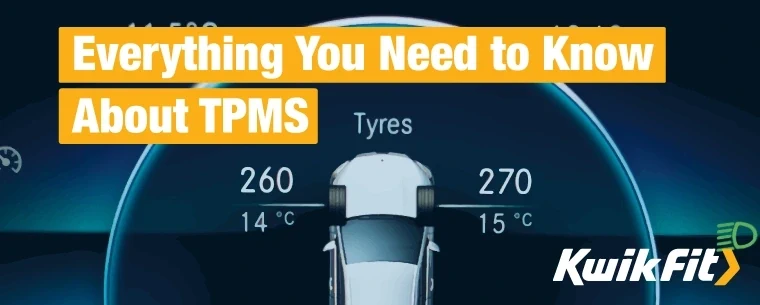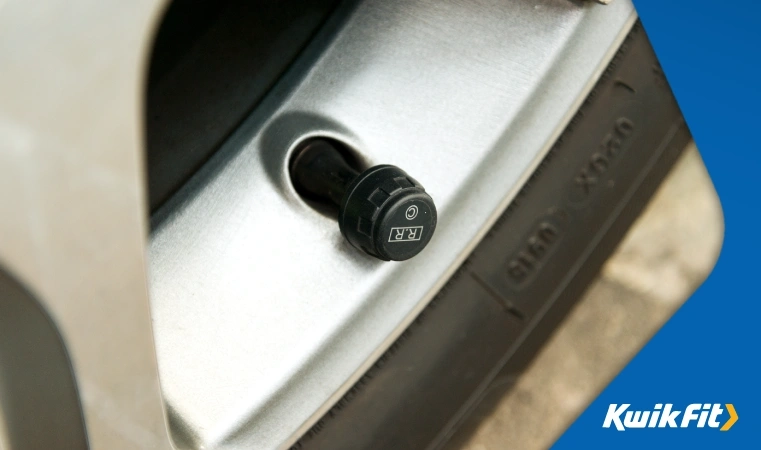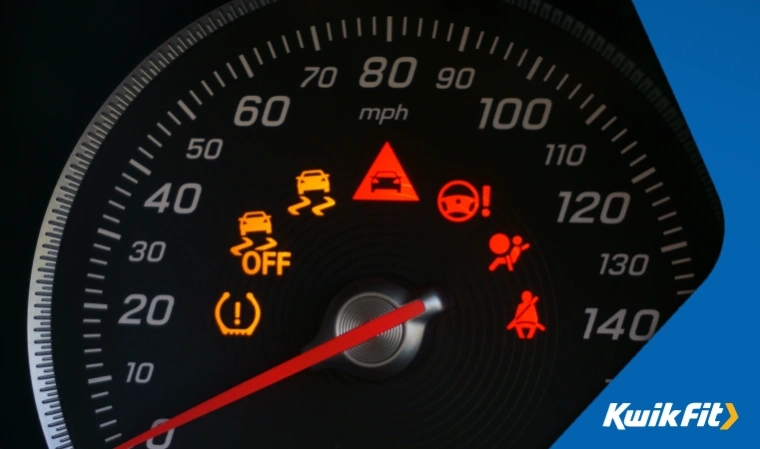How do Tyre Pressure Sensors (TPMS) work?
Jack Dreyer | Wednesday 1st November 2023 9:00am

Have you ever had an alert appear on your vehicleís dashboard that tells you that your tyre pressure is low? If youíve experienced this, then your vehicle will be fitted with TPMS. These systems are very useful and can be found in all vehicles that have been manufactured since 2014.
But how do tyre pressure sensors work? And, more importantly, how do they help drivers stay safer behind the wheel? Read on to find out.
What is TPMS?
Tyre Pressure Monitoring Systems (shortened to TPMS) are fitted to modern vehicles to monitor tyre pressure - and report low pressure or tyre pressure imbalances on a vehicle.
Within the TPMS is a sensor that triggers a warning light when there is a drop in pressure of between 6-7 PSI - although some manufacturers set their warning lights to come on when sensors detect much smaller decreases, for additional peace of mind.
These devices can be used to determine whether your tyre is frequently leaking air, either through the trim or because of a slow puncture. Solving this problem quickly could reduce the chances of an accident occurring due to a blowout or a flat tyre.
How do car tyre pressure sensors work?
The two main types of TPMS are direct and indirect.
Direct TPMS
Direct TPMSs are the most common, as theyíre more reliable. This system uses pressure sensors that are located within the tyre to track the pressure. Because of their location, they can track the exact pressure within the tyre, making them accurate and reliable.
When the pressure drops past a set parameter Ė usually 25% Ė a warning alert will appear on your dashboard. At this point, the car should be taken to a petrol station to have its tyres pumped up. Some TPMSs will even specify which tyre is low, so you donít have to manually check them all.
These sensors are fitted with an internal battery, however, battery failure is the main reason TPMSs stop working. The more miles you do, the quicker the sensor will run down. Unfortunately, for them to work properly, they need to be sealed units Ė so you canít simply replace the battery when it runs out.
Indirect TPMS
Indirect TPMSs donít have their own sensor. Instead, they use another sensor thatís located inside the wheel, usually the anti-lock braking systemís sensor. This works by tracking the tyres as they revolve.
A tyre that is underinflated will have a smaller radius than a tyre thatís properly inflated, and therefore it will make more or irregular turns. This is how the sensor detects that the pressure could be low. This kind of system is less accurate, but is still able to tell you when a tyre requires more air.

Regular signal from an indirect TPMS showing normal tyre pressure

Irregular signal from an indirect TPMS showing lower tyre pressure
As a whole, these sensors can be very beneficial. If your car is frequently telling you that one tyre is low, then it may have a slow puncture, or could be leaking air from the trim. You should take it to your local garage to have it looked at, and you might need to get a replacement.
Driving with under-inflated tyres could also have an impact on their lifespan - they may wear down more quickly, or even have an impact on your steering and fuel usage. To prevent this, you should ensure that your tyre pressure mirrors the manufacturerís recommendation.
If youíve re-inflated your tyre to the correct air pressure and the warning alert is still on your dashboard, you may have a faulty sensor that needs replacing. This is worth mentioning to your mechanic when you next visit.
Where are tyre pressure sensors located?
Direct TPMS sensors are located within the tyre, usually in the space between the tyre and the wheel trim. As indirect TPMSs use the sensor on the anti-lock braking system (ABS), this sensor is typically located near the brake rotor. The wheel may need to be removed in order to gain access to the sensor.
When was TPMS invented?
Although it has only become a standard feature in the manufacturing of motor vehicles within the last decade, TPMS is in no way a new technology. In fact, you'd have to go way back to 1977 to find its origins Ė while the Porsche 911 was the first commercial car to go on sale with a TPMS in 1983.
Renault later adopted the safety system in 1992 for the Renault Laguna and Megane Scenic. But it wasnít until between 2005 and 2007 that TPMS was introduced in the US automotive industry as the standard for all new cars.
TPMS became more widely recognised in the UK and Europe when EU legislation laws were passed in 2009, stating that from November 2012 all new models of cars must have TPMS as standard.

Is TPMS a legal requirement in the UK?
Yes, since 2012, TPMS (Tyre Pressure Monitoring System) has been a legal requirement for all new passenger vehicles sold in the UK. When the tyre pressure is low or there is a puncture in one of the tyres, the system notifies the driver. It should be noted, however, that TPMS does not replace the necessity for regular tyre maintenance and inspections - it should simply help to alert you to changes or issues alongside your regular maintenance schedule.
Why is tyre pressure important?
So, why is the monitoring of tyre pressure important? According to the charity Tyre Safe, 1,200 people are killed on Britainís roads annually because of incorrect tyre pressures. It is also estimated that another 5,000 deaths per annum can be attributed to incorrect tyre pressure (though these numbers canít be proved).
So, to keep you, your passengers, and other road users safe, maintain your tyres, ensure your tyre pressure is correct, and keep an eye on your TPMS.
Another reason to ensure your TPMS is working properly on a regular basis is the potential MOT implication. Since early 2015 having a faulty TPMS can cause instant MOT failure if the TPMS dashboard light stays on to indicate a fault or problem with the valves.
Removing & cleaning a tyre pressure sensor
Occasionally, an indirect TPMS sensor Ė an ABS sensor Ė may need cleaning because of where it is located:
- First, you should check your carís handbook to find exactly where it is situated.
- Once you know where it is, youíll need to safely take the tyre off. Ensure that youíre using stable jack stands for this job, as you donít want the car to fall off them.
- When the wheel has been taken off, turn the steering wheel so itís pointing in the opposite direction to the side youíre working on. For example, if youíre working on the passenger side, turn the steering wheel to the driverís side.
- An extra safety tip is to put the removed wheel underneath the car (usually under the axle) as a backup Ė if the jack stands do happen to fail, then at least the carís not going to crash fully into the floor.
- Now that the tyre is off, you should be able to see the sensor more clearly. Itíll be bolted in place, so you will need to remove these bolts using a socket wrench.
- Once all the bolts are removed, you should be able to remove the sensor easily. Using a soap and water solution, carefully clean the sensor with a cloth. Bolt it back into place and refit the tyre.
Replacing or removing the direct TPMS sensor isnít as easy, because itís part of the tyreís valve stem Ė so youíd need to actually remove the tyre from the wheel to access it. If you have concerns about the performance of your TPMS, itís best to get in touch with your local Kwik Fit centre for reliable service and advice you can trust.

Maintain your TPMS at Kwik Fit
At Kwik Fit, we believe in preventative maintenance. We replace the valve every time a tyre is removed from its rim. As the TPMS sensor is just a more complex form of valve, we can service all the various components of the sensor - thus ensuring TPMS valve integrity.
If your vehicle doesnít have a TPMS, donít worry - you can use our Tyre Pressure Search tool to determine your vehicleís optimum tyre pressure, and ensure you stay safer on the road. If you have any other questions about your TPMS, get in touch with Kwik Fit today and we can point you in the right direction.
Any facts, figures and prices shown in our blog articles are correct at time of publication.
Featured Articles
Is it Illegal to Drive With One Headlight?
Saturday 19th July 2025
Wondering if itís illegal to drive with one headlight? Learn about the safety risks and penalties of illegal blown bulbs and why you should fix them promptly.
Air Con in EVs & Hybrids: Experts Answer Your Questions
Monday 30th June 2025
Does air con drain EV batteries? Can you use the air con while charging an electric car? Find out the answers to these questions & more from Kwik Fitís experts.
Why Is Your Car Making a Noise? Fixes & Tips
Friday 13th June 2025
When your car starts making unexpected noises, it can certainly be quite disconcerting; it may be nothing to worry about, but hereís what you need to know.









